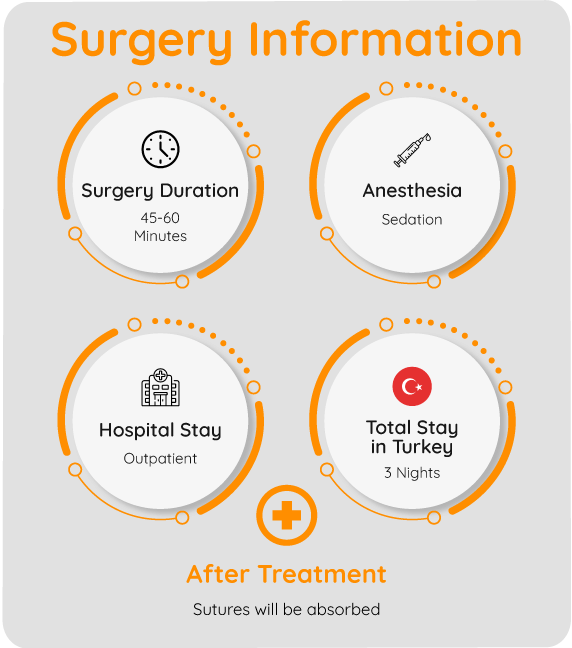At the Badge Clinic, we specialize in labiaplasty surgery in Turkey, offering exceptional expertise and a track record of success in the field. If you’re considering labia reduction surgery, our team of experienced Turkey cosmetic surgery professionals can guide you through the process and help you achieve the confidence and comfort you desire.
We’ll get back to you within one business day (via e-mail & WhatsApp)
Labiaplasty surgery, also known as labia reduction surgery, is a cosmetic procedure aimed at altering the size and shape of the labia minora or majora. Many opt for this surgery to enhance their genital aesthetics, alleviate physical discomfort, or improve their self-esteem.




Choosing labiaplasty in Turkey offers several advantages. First and foremost, Turkey has become a renowned medical tourism destination, known for its advanced healthcare facilities and affordable prices. By opting for labiaplasty in Turkey, you can benefit from high-quality medical care while also enjoying a cost-effective solution.
At Badge Clinic, our highly skilled surgeons are experts in labia reduction surgery, providing personalized treatment plans tailored to each patient’s unique needs. Our goal is to help you achieve the desired aesthetic results while prioritizing your comfort and safety throughout the entire process.
Before undergoing labia reduction in Turkey, it’s crucial to have a comprehensive understanding of the process. During the initial consultation, our experienced medical professionals will assess your specific concerns and goals, answering any questions you may have.
The actual labiaplasty surgery typically involves the removal of excess tissue or reshaping of the labia. Depending on your individual case, the procedure can be performed under local or general anesthesia. Our team will guide you through the entire surgical process, ensuring your comfort and well-being.



When it comes to labia reduction surgery, choosing the right clinic is crucial. Badge Clinic stands out as a trusted and reputable institution for labiaplasty in Turkey. Our clinic boasts a team of highly skilled and experienced surgeons who prioritize patient satisfaction and safety.
We strive to provide a supportive and comfortable environment for our patients, ensuring that your concerns and desires are heard and addressed. If you are an individual who is considering other procedures, such as boob jobs in Turkey or a Turkey BBL, contact the Badge Clinic for more information.
Cost is an important consideration for many patients seeking labiaplasty surgery. Turkey offers a cost-effective solution for individuals looking to undergo this procedure without compromising on quality. We provide transparent pricing, and our dedicated team will guide you through the financial aspects of your procedure.




To begin your journey towards achieving your desired results, a labiaplasty surgery consultation at Badge Clinic is the first step. During this consultation, our experts will assess your individual needs, discuss your expectations, and provide you with detailed information about the procedure.
Contact us today to book your consultation for labia reduction in Turkey.
Labiaplasty aims to reduce the size of the labia minora so that they no longer extend beyond the labia majora. This procedure is performed to address asymmetry, where one labium is longer than the other, or to shorten both labia to prevent discomfort and prevent them from protruding out of swimwear.
Labiaplasty can be carried out using local anesthesia with oral sedation or under general anesthesia.
The most common technique used is the trim procedure, which involves removing excess tissue and directly suturing the area. Another popular technique is the wedge procedure, where a piece of tissue is removed while maintaining a natural border. Excess folds of the clitoral hood can be reduced during the procedure.
Most patients typically take a week off from work to allow for recovery. During this time, they can alleviate swelling and pain by applying a cold pack, wrapped in underpants and an elastic garment like Spanx, for twenty minutes on and twenty minutes off.
Patients can usually resume using tampons and engaging in sexual intercourse after four to six weeks. Trim labiaplasty generally has a quicker recovery.
Labiaplasty typically results in shorter labia that no longer hang below the level of the labia majora. Patients who experienced discomfort from twisting and tugging of their labia often find relief after the surgery.
A clitoral hood reduction involves reducing excess folds of the clitoral hood or prepuce. This procedure can address the bulge caused by excessive folds, especially when combined with labiaplasty. It helps improve the overall appearance and balance of the female genitalia. Clitoral hood reduction is commonly performed in conjunction with labiaplasty.